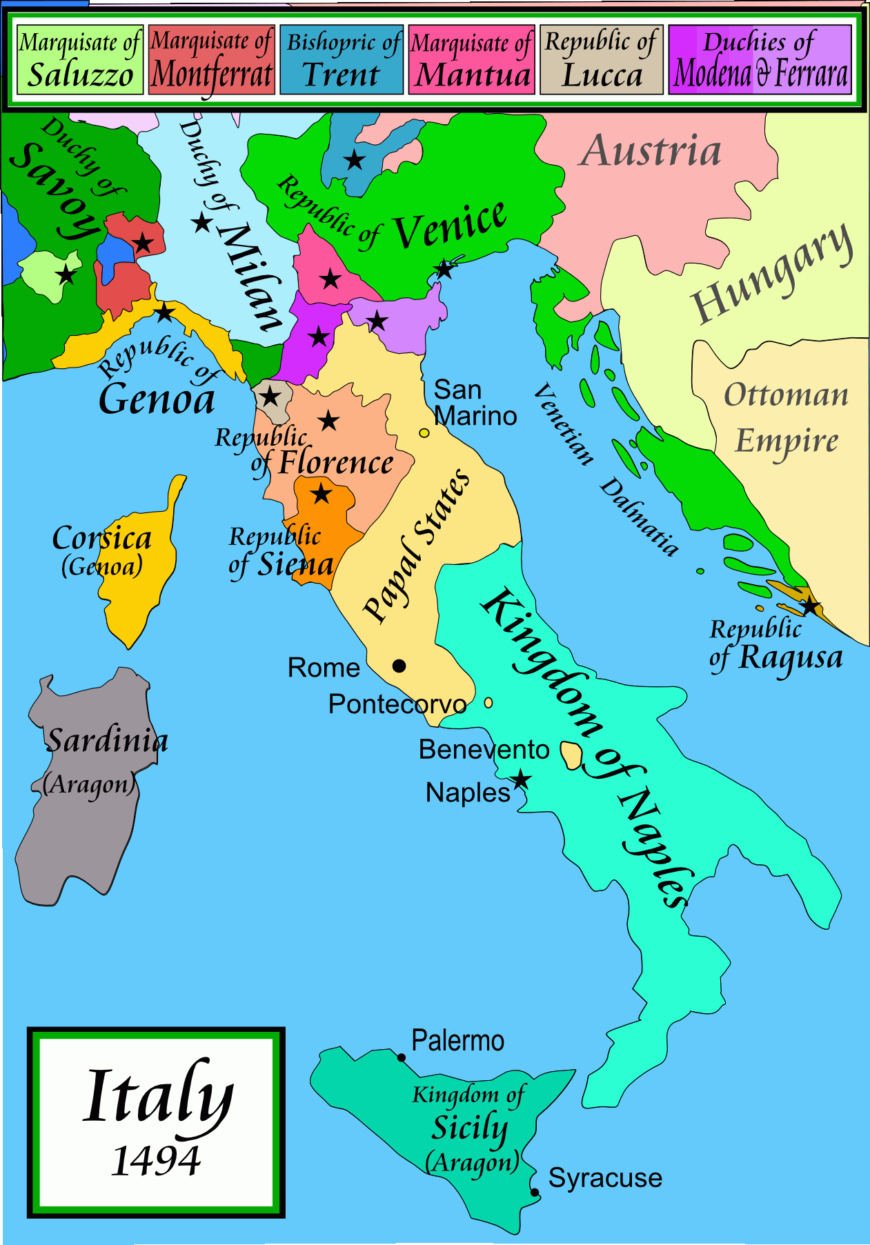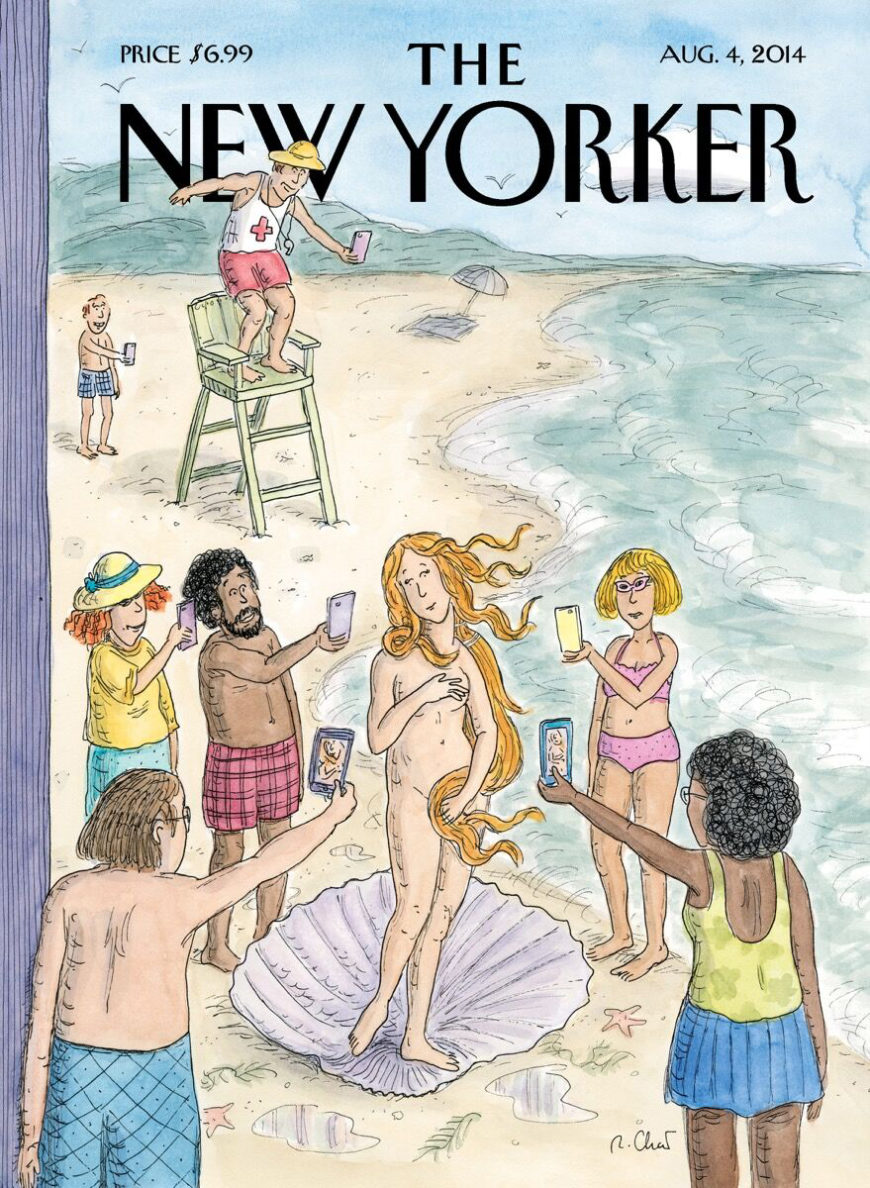The noble achievements of our far-off ancestors, the men of ancient Rome, are forgotten, and have become impossible to modern men. Where was the painter’s art till Giotto tardily restored it? A caricature of the art human delineation! Sculpture and architecture for long years sunk to the merest travesty of art and are only today in the process of rescue from obscurity; only now are they being brought to a new pitch of perfection by men of genius and erudition. Of letters and liberal art at large, it is best to be silent altogether. For these, the real guides to distinction in all the arts, the solid foundation of all civilization, have been lost to mankind for 800 years and more. It is but in our own day that men dare boast that they see the dawn of better things. Matteo Palmieri, La vita civile (1429) [1]
These sentiments, expressed by the Florentine humanist, Matteo Palmieri, in his dialogue on civic life and the virtues of the perfect citizen, eloquently evoke the optimism of renaissance humanism. Despite living in an age of war and plague, Palmieri and his contemporaries characterized their era as a riniscita, or rebirth of classical culture based on humanism—an educational program rooted in the writings of ancient Greek and Latin authors that extolled the active life of the citizen and praised humanity’s capacity to achieve greatness through knowledge and free will. Humanism looked to antiquity for inspiration in reforming society and had a tremendous impact on all aspects of life in renaissance Italy—and Europe more broadly—from government to the arts.
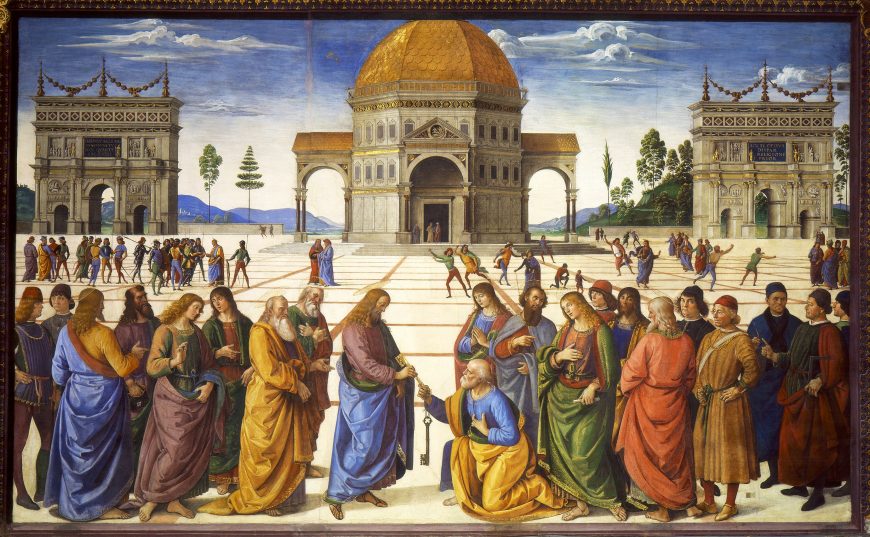
Perugino’s fresco demonstrates humanism’s influence on the arts in the Renaissance. Two classical arches with Ionic columns as well as an octagonal temple occupy the background. The fresco also depicts the vibrant life of Renaissance cities: young men play ball or strut in groups in a large square—itself a testament to rational city-planning schemes of humanists and artists. Perugino, Christ Giving the Keys of the Kingdom to St. Peter, Sistine Chapel, 1481-83, fresco, 10 feet 10 inches x 18 feet (Vatican, Rome)
Much of the artistic output of the renaissance was the product of a fruitful dialogue between artists and humanists. Wealthy patrons sponsored the careers of humanists and favored artistic works influenced by ideas derived from Greco-Roman antiquity. Artists who were inspired by humanists’ revived interest in antiquity also used ancient Greek and Roman models to inform their works. Filippo Brunelleschi and Donatello traveled to Rome to learn the principles of harmony, symmetry, and perspective by viewing its ancient ruins and statuary firsthand, and artists (including Sandro Botticelli and Pietro Perugino) began depicting classical poses and mythological allegories in their paintings. [2] Much of Italian renaissance art—even overtly religious works—was grounded in humanistic principles.
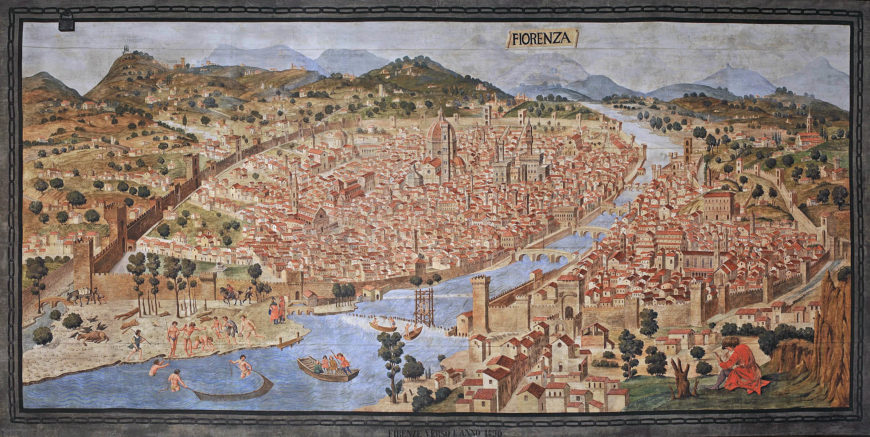
This map of Florence reveals the development of linear perspective and bird’s eye mapping techniques that developed in the Renaissance. Medieval maps of cities were often spatially flat and relied on symbolism to depict important buildings and sites. Veduta della catena (chain map) of Florence, c. 1471–72, attributed to Francesco and Raffaello Petrini, etching, 1.25 x 1.38 m (Palazzo Vecchio, Florence)
What was humanism?
Humanism was the educational and intellectual program of the Renaissance. Grounded in Latin and Greek literature, it developed first in Italy in the middle of the fourteenth century and then spread to the rest of Europe by the late fifteenth century. This program, called the studia humanitatis, or the humanities, was thought to teach citizens the morals necessary to lead an active, virtuous life, which its proponents contrasted with the contemplative life of ascetic monks and scholars. As a product of the Italian city-state republics, humanism was a system born in the city and made for the citizen. Although scholars in earlier centuries had embraced classical learning, humanists rediscovered many lost texts, read them with a critical and secular eye, and, through them, forged a new mentality that shaped Italian and European society from from approximately the mid-14th to the mid-17th centuries.
Origins
Although humanist ideas had circulated in Italy since the late twelfth century, their main proponent was the Florentine poet, Francesco Petrarch. Born into an exiled family, Petrarch grew up in the French city of Avignon and attended law school in Bologna. Inspired by his love of antiquity and the Latin writings of Cicero, Petrarch rejected the legal profession to pursue the life of a poet and collector of ancient texts. He spent much of his free time hunting for lost and neglected works of classical authors and twice found major caches of Cicero’s writing, most notably an unknown collection of Cicero’s letters, the Epistolae ad Atticum, in the chapter library of the Verona Cathedral in 1345. He copied the manuscript in the library and soon circulated it among his friends and associates. By the fifteenth century, through the efforts of Petrarch and his followers, Cicero’s taut, philosophical style of writing became the standard in Latin prose.
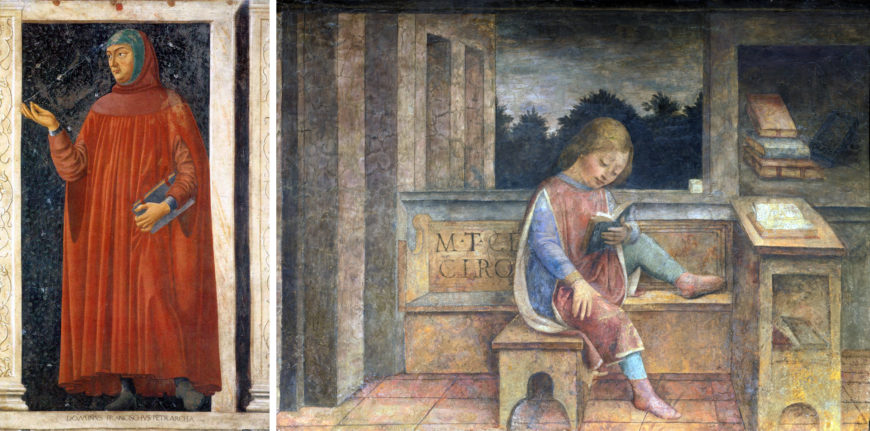
Left: Petrarch achieved fame for his Latin and Italian poetry in his lifetime. In 1341, he was the second writer to receive the laureate for his poetry since antiquity. Andrea del Castagno, Francesco Petrarch, c. 1450, fresco on wood, 247 x 153 cm (Uffizi, Florence); right: This fanciful fresco depicts Cicero as a child reading a book. The image highlights the advent of solitary, silent reading that was coming to replace the tradition of oral reading during the Renaissance. Depictions of solitary readers in their study were popular throughout the period. Vicenzo Foppa, The Young Cicero Reading, c. 1464, fresco, 101.6 x 143.7 cm (Wallace Collection)
Through these letters and other ancient texts, Petrarch was able to enter the Roman world so distant to him. Petrarch was the first scholar to recognize the cultural gap between his own age and Cicero’s. Of course, previous scholars throughout the middle ages made use of classical literature, but they read these texts through strict religious lenses and saw themselves inhabiting the same culture as Julius Caesar and emperor Augustus. It was just a world grown old and ruined by time. Petrarch, with his historical consciousness, recognized that he and his fellow Italians were living in a world starkly different from their Roman ancestors with a different set of values. Petrarch advocated reading Cicero and other Roman authors as a means of finding models for eloquence and exemplary comportment.
To highlight this cultural gap between ancient Rome and fourteenth-century Italy, Petrarch envisioned a new way of conceptualizing the past. He portrayed antiquity as a golden age, replete with virtuous men, great deeds, and good morals. It was the period from the fall of Rome right up to his own age that was, to his thinking, the dark age. Indeed, Petrarch coined the term “medio evo” (middle ages) to connote the decline of Roman values, letters, and arts. Petrarch greatly exaggerated the decline of culture in the middle ages with its towering cathedrals and innovations in trade, science, and theology. Regardless, Petrarch pictured his age as a rinascita (rebirth) of classical learning and culture, and created an image of the middle ages as dark and ignorant—an idea that still persists (problematically) to this day.
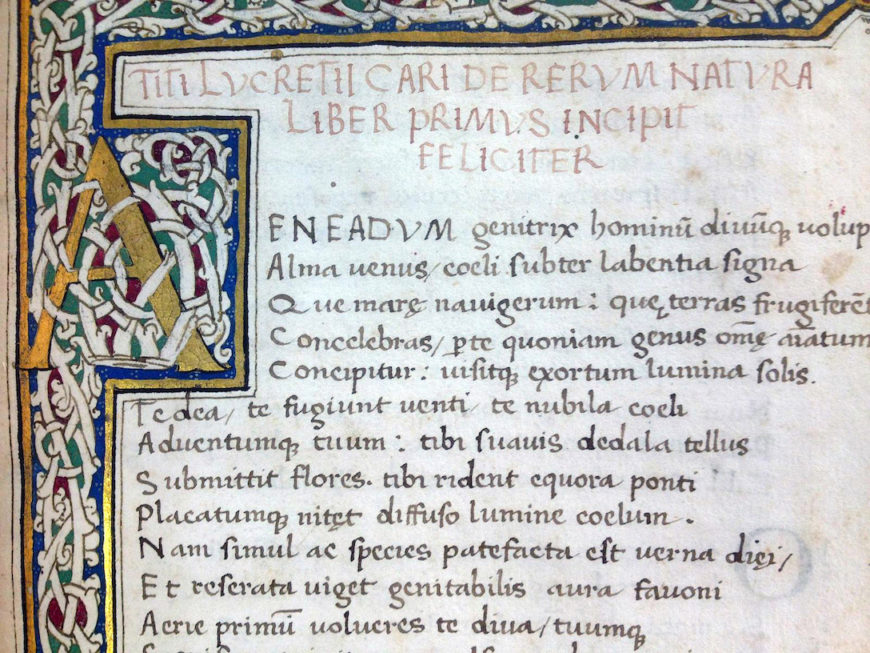
This page from a manuscript edition of Lucretius’s De Rerum Natura demonstrates the humanistic script—called italic—that allowed others to easily read and make transcriptions of ancient texts. Lucretius’s philosophical poem was discovered by the humanist, Poggio Bracciolini, in a German monastery in 1417. This manuscript is a later transcription, made in Paris in 1563. (University of Cambridge)
Petrarch’s tolling of the bell to revive Roman antiquity reached appreciative ears. By the early fifteenth century, humanists actively scoured dusty monastic libraries in Italy, France, and Germany, finding more letters of Cicero, Lucretius’s Epicurean poem, On the Nature of Things (De Rerum Natura), and a host of other ancient texts. Greek scholars, fleeing from the Ottoman attacks on the Byzantine Empire, brought Homer, Plato, Sophocles, and other Greek manuscripts to Italy, as well as taught ancient Greek to a generation of humanists, hungry for learning and for a connection with antiquity.
Who were the humanists?
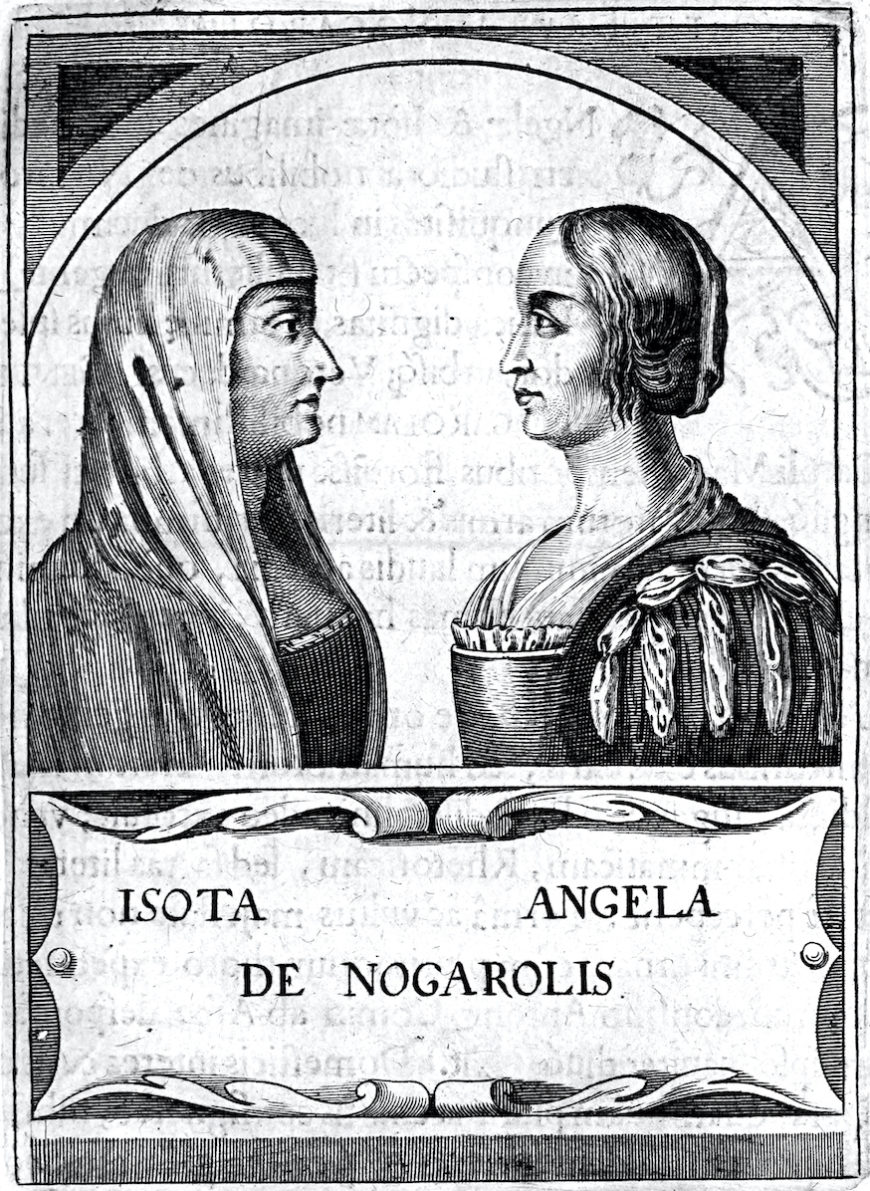
Nogarola is most famous for her debate with the patrician humanist, Ludovico Foscarini, that resulted in Dialogue on Adam and Eve (1451). Isotta Nogarola, with Angela Nogarola (her aunt poetess), Elogia Virorum Literis & Sapientia Illustrium … imaginibus exornata Seite 339 (Ill.) (Padova: Sardi, 1644)
Humanists were a diverse group as individuals but shared a common passion for antiquity and for Latin prose and rhetoric. Most humanists came from relatively well-heeled backgrounds—they were sons of noblemen, patricians, merchants, and notaries. Many patrician women, like Laura Cereta and Isotta Nogarola, were able to acquire a humanist education and take part in the intellectual life of the renaissance, but moralists frequently discouraged them from pursuing the active life of a teacher, professor, or writer. Nogarola, a writer from Verona, had acquired an education in the studia humanitatis and entered into debates on the role of women in Renaissance society with male humanists. Due to the hostile reception of her activity in humanist circles that questioned her chastity, she retired from the public, never married, and concentrated on sacred literature rather than secular writings. Patrician and noble women, however, often expressed their humanist interests by commissioning works of arts inspired by the classical tradition. Isabella d’Este, the Marquise of Mantua, gained fame as a patron of such Renaissance painters as Giovanni Bellini, Andrea Mantegna, and Pietro Perugino.
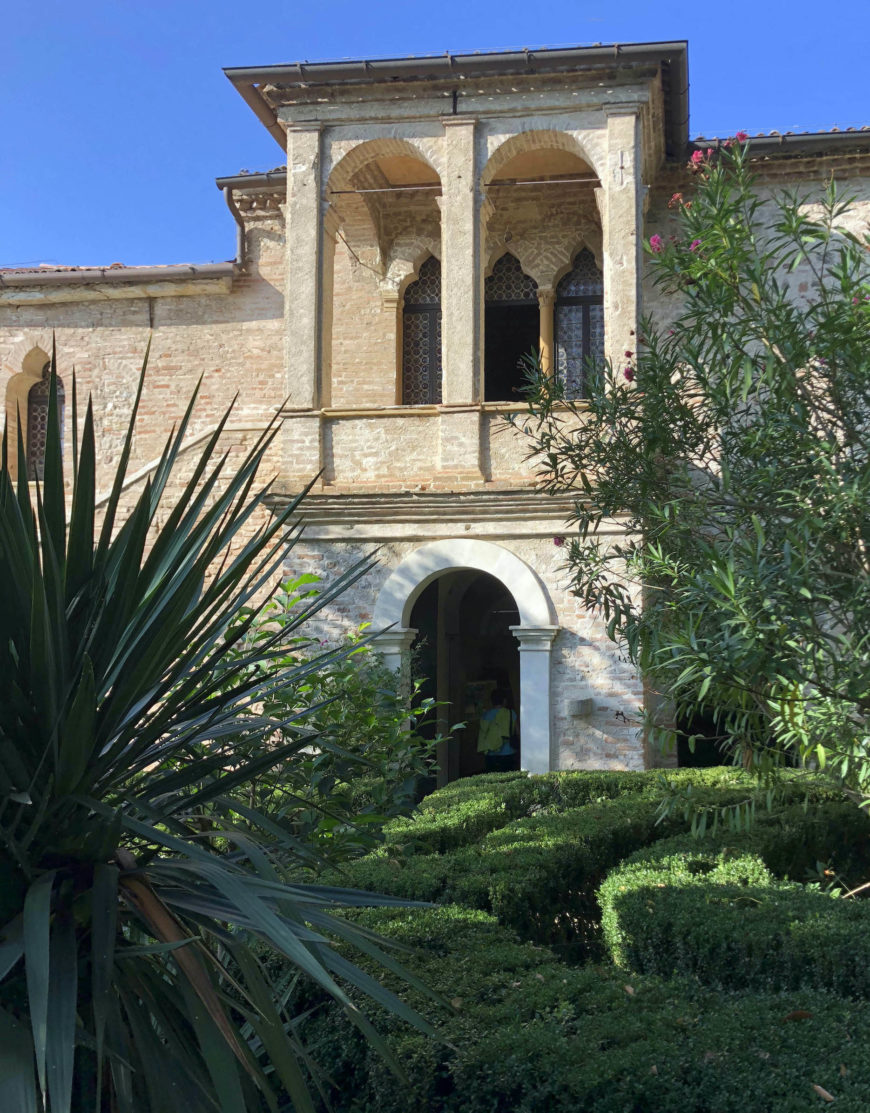
Villa Petrarca, in the Paduan town of Arquà Petrarca (photo: John M. Hunt). In the years after Petrarch’s death, the villa became associated with the famous humanist. In 1546, the patrician, Paolo Valdezocco, bought the house and transformed it into a shrine dedicated the poet’s life.
However, many humanists came from humbler backgrounds but managed to obtain their education through patronage, natural talent, and hard work. Indeed, humanists were the first western scholars to argue for a nobility of spirit, based on merit and skill, rather than a nobility of blood, based on lineage and ancestry. Most humanists found work as professors, librarians, and secretaries for princes and state chanceries. The prime goal of most humanists was to find a patron willing to support their intellectual activities. Petrarch was able to retire in a villa in the Euganean Hills thanks to patronage from the Carrara despots of Padua. Cosimo de’ Medici allowed Marsilio Ficino the use of his villa in Careggi as a writing retreat. With secure positions, humanists could complete their work in exchange for writing poems, orations, and histories that extolled the virtue, power, and magnanimity of their patrons. For every Petrarch and Ficino, whose fame and learning attracted patrons, there were probably ten humanists who had to scrape by as tutors or secondary-school teachers.
The humanist agenda
Humanists sought to rediscover lost and forgotten texts, purge them of mistakes made by monastic scribes through a rigorous philological analysis, and circulate them in handwritten copies (later, with the advent of the printing press, humanists began to publish printed versions of these texts). In the mid-fifteenth century, after the introduction of Greek texts into Italy due to Ottoman attacks on the Byzantine Empire, humanists translated these texts into Latin, making them more accessible to those who could not read Greek. They often made copious annotations in these manuscripts to help the reader understand them. Moreover, they often published their own works which consciously emulated the style and substance of the ancient authors.
At their core, humanists were educators. They devised their educational program, the studia humanitatis, in complete opposition to the Scholastic tradition (based on logic and theology) that had gained prominence in the middle ages. Humanists wanted a curriculum that would not make theologians but make citizens useful to governments and society. They placed five disciplines in the curriculum of the studia humanitatis: grammar, rhetoric, poetry, moral philosophy, and history. Each of these disciplines served a specific purpose in fostering virtuous, active citizens of the city-states. These subjects, based on reading Latin (and, later, Greek) authors was to arm citizens with the eloquence, morality, and examples of virtuous behavior of the ancients. The values of the ancient Romans and Greeks would perfect citizens and help them realize their potential as individuals endowed with free will to know the good and to act on it.
Like Plato and other ancient philosophers that preceded them, the humanists aspired to have princes implement their ideas of moral reform. Many, like Leon Battista Alberti, had grand visions of city-planning, which only a prince or a government could execute. Humanists also sought to change Italian society at the individual level by creating uomini universali—well-rounded men who could be useful to society.
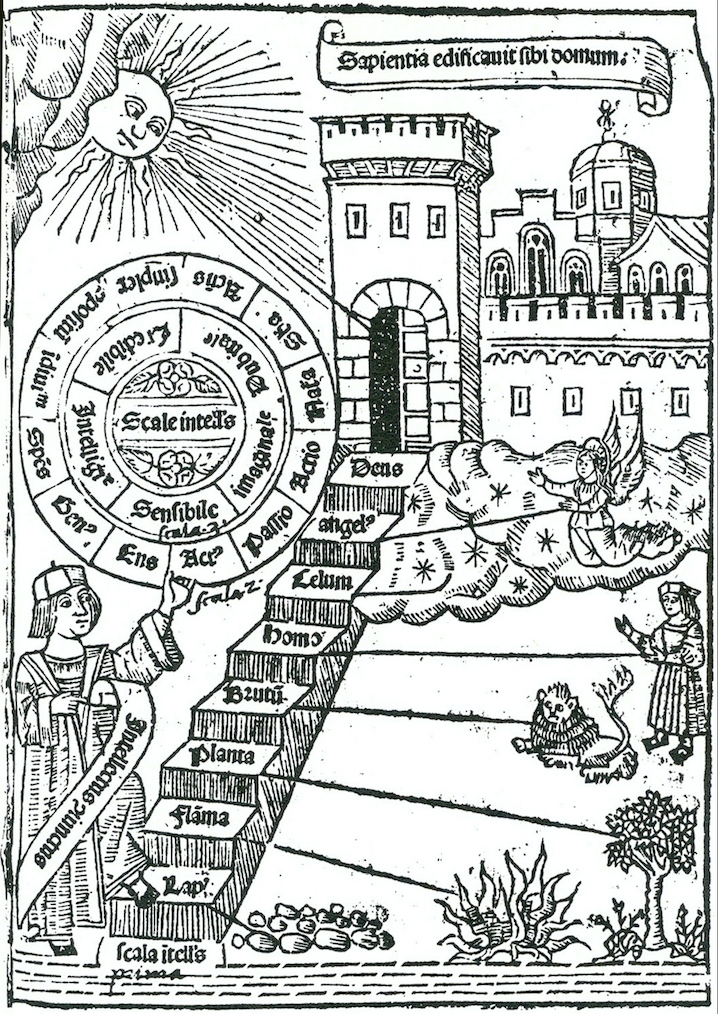
Medieval and renaissance intellectuals conceived the chain of being as a ladder or stairway. With their bold emphasis on free will, renaissance humanists, such as Pico della Mirandola, argued that individuals were not rooted in one place on the ladder but could move up or down the chain of being. Ramon Lull’s Ladder of Ascent and Descent of the Mind, first printed in 1305, here 1512 (Niedersächsische Staats- und Universitätsbibliothek, Göttingen)
Although having diverse views on philosophical matters, humanists were united by a secular view of humanity’s place in the world. They gave orations on and debated the idea of the dignity of man. This concept gained momentum with the revival of Neoplatonism after Marsilio Ficino’s translation of the entire corpus of Plato’s extant works in 1469 and his harmonizing of Christian theology with Platonic ideas.
Ficino’s pupil, Giovanni Pico della Mirandola, took this idea further in his Oration on the Dignity of Man, written in 1486. Pico argued that in the chain of being humans occupied a privileged space due their capacity to learn and grow as individuals. They were the median between God and animal and plant life; and they could become “terrestrial gods” due to this thirst for knowledge or stagnate from ignorance. Human dignity lay in this free will—humans could choose where they stood in the chain of being and played a role in shaping themselves and the world.
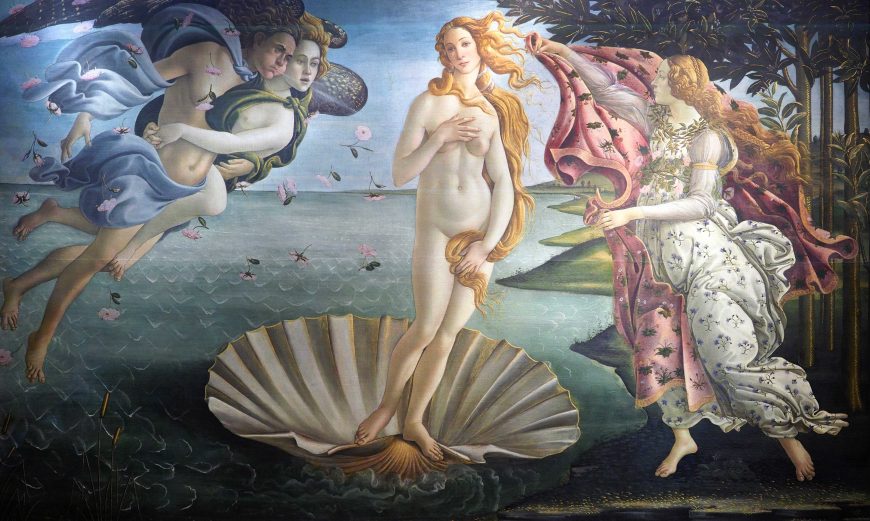
Much of the iconography and story-line of Botticelli’s fresco was influenced by Marsilio Ficino and the writings of Angelo Poliziano, the court poet of Lorenzo “the Magnificent” de’ Medici. Sandro Botticelli, The Birth of Venus, 1483-85, tempera on panel, 68 x 109 5/8″ (172.5 x 278.5 cm) (Galeria degli Uffizi, Florence; photo: Steven Zucker, CC BY-NC-SA 2.0)
Moreover, humanists not only praised human dignity but also the human body. Rather than being something to hide and be ashamed of, humanists and artists of the renaissance began to depict for the first time since antiquity favorable images of the nude human body, and on a large scale not seen since antiquity. For instance, Venus was portrayed in her classical pose, the Venus pudica—naked but modestly covering her nudity with her arms and long hair rather than as a fully clothed aristocratic woman, as medieval artists had portrayed the goddess. The motif of the Venus pudica is best represented by Botticelli’s Birth of Venus, commissioned by the Medici family in the early 1480s. Even biblical figures could be portrayed in their human nakedness. Nothing like this was possible before 1400 since medieval moralists had nothing but contempt for the human body, seeing it as a receptacle of sin and generally depicted it negatively.
Humanism and the arts today
Humanism continues to shape our social, visual, and intellectual world. The liberal arts education of modern universities is based on the humanistic educational program and its principles. Students must take core requirements in history, literature, and languages during their first two years. The goal of university educators, like their humanist forebears, is to create well-rounded citizens who can make contributions to their communities and the world. Humanists, like university professors, optimistically believed in the liberating power of an education and its power to transform lives. The art of the renaissance influenced by humanism provides a visual framework for much of the world.
Botticelli’s Birth of Venus is a case in point. Images of the painting have been used on t-shirts, coffee mugs, magnets, and even shoes. Even those without a deep knowledge of antiquity, renaissance or art recognize the pose and hair of Botticelli’s Venus. The fact that this art can be found everywhere in society from television advertisements to street graffiti in cities attests to its enduring relevance.
Notes:
[1] W. H. Woodward, Studies in Education during the Age of the Renaissance (Cambridge University Press, 1906), p. 67.
[2] Vasari tells us that Brunelleschi went to Rome to measure the ancient ruins. Giorgio Vasari, The Lives of the Artists (Oxford: Oxford University Press, 2008), pp. 116–17.
Additional resources:
Read another essay about humanism and Italian renaissance art on Smarthistory
Read more about Greek painters making their way to renaissance Venice
Burke, Peter. The Italian Renaissance: Culture and Society, 3rd edition. Princeton University Press, 2014.
Celenza, Christopher S. The Lost Italian Renaissance: Humanists, Historians, and Latin’s Legacy. Johns Hopkins University Press, 2004.
Dempsey, Charles. The Portrayal of Love: Botticelli’s Primavera and Humanistic Culture at the Time of Lorenzo the Magnificent. Princeton University Press, 1992.
Grendler, Paul F. Schooling in Renaissance Italy: Literacy and Learning, 1300-1600. Johns Hopkins University Press, 1989.
Hankins, James. Virtue Politics: Soulcraft and Statecraft in Renaissance Italy. Harvard University Press, 2019.
King, Margaret L. and Albert Rabil, eds. Her Immaculate Hand: Selected Works by and about Women Humanists of Quattrocento Italy. Center for Medieval and Early Renaissance Studies, 1983.
Kristeller, Paul Oskar, Renaissance Thought and Its Sources. Columbia University Press, 1979.
Panofsky, Studies in Iconology: Humanistic Themes in the Art of the Renaissance. Icon, 1972.
Seznec, Jean. The Survival of the Pagan Gods: The Mythological Tradition and Its Place in Renaissance Humanism and Art. Princeton University Press, 1953.

